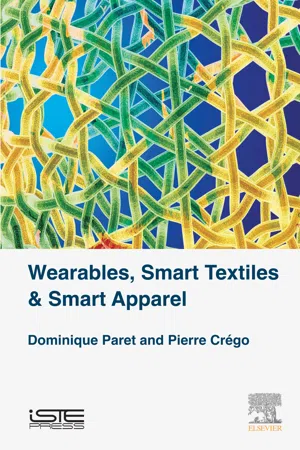1.1 A few definitions
In order to launch directly into the core of the subject and to give context to our words, let us begin by carrying out a little reminder of the vocabulary with a series of definitions around the terms “Wearables” and C°.
1.1.1 Wearables
The barbaric word “Wearables” comes from the English verb to wear = to carry or have on the body. “Wearables” is therefore a generic word encompassing a multitude of elements that can be worn, the very varied elements that we wear, or that we can wear on ourselves or in ourselves (for example, clothes, accessories, watches, shoes, pair of glasses, medical devices (heart, prostheses, implants, etc.), elements that have a role in the wellbeing of an individual, etc.).
“Wearables” – in the broad sense of the term – are an enormous sub-group of “Objects” that can be connected (or not), endowed with an intelligence (or not), communicating (or not) through associated (or not) radio connections to networks (the Internet, for example). We do not write in this repetitive way above with a series of “or not” for comic effects, but because, by conflation, many people make too many shortcuts, as we will see throughout this book.
“Connected Wearables” are in fact a specific sub-group of connected Objects that can be linked to the Internet (or not). Since each word requires several explanations, let us look at each of these terms.
1.1.2 Objects
In this book, under the term “Objects” with a capital “O”, we will include all that we find in the daily literature under the terms “devices”, “elements”, “nodes”, “end devices, “endpoints”, “terminals”, etc., in short, all “things“, big or small, that act as starting points for information that we should or would like to exploit.
Here, in this book, the Object will itself be “Wearable”!
1.1.3 Connected
Yes, certainly, but connected to what, how, why and so on, at what price. These days, uni/bi-directional, “Wireless” or so-called “contactless” connections are in style. This being said, we should remain simple and keep our eyes open. It has been several (dozen) years since people began building radiofrequency identification systems (RFID), contactless smart cards, NFC, Zigbee, BT & BLE Bluetooth, Wi-Fi, etc., and, just like Mr Jourdain speaking prose all his life without knowing it, made “connected Objects”, even secured – sometimes very secured – “Wireless”!
A General Public “automobile”-type example:
For 15 years, an electronic valve has been a connected Object (in UHF) in car electronics and it is not an IoT!
So, this current trend really is not a scoop except for a certain crowd and its “followers” or “geeks” who are hungry for new words, even if they express the same thing as the old ones! Moreover, if they simply connect with each other through any type of simple link and they become simple “Connected Objects” or via a specific Internet link (which very much complicates matters), then we refer to “IoT” or “IoE”, but this is not an end in itself.
1.1.4 IoT
IoT – Internet of Things, so an Internet network connection must be available to use this term! IoT is often defined as a network of Objects generally incorporating an “embedded”(integrated, onboard) type of technology of sensors, electronics, software and connectivity in order to detect, to communicate or to interact with their internal states and/or the external environment and to exchange data with a manufacturer, a maker, a service provider or other connected elements.
It should be noted that the IoT functions under the auspices of the ITU – International Telecommunications Union – Global Standards Initiative (IoT-GSI) via multiple communication protocols connecting them with each other such as Bluetooth, ZigBee, Long Range Wide Area Network, LoRa and SIGFOX.
Often, and through the abuse of language, for many people, the Internet of Things covers all so-called connected products that are followed by mobile applications (watches, scales, bracelets, toothbrushes, fridges, etc.) that often do not need the Internet at all and only use other methods of communication such as NFC, BLE or Wi-Fi, for example!
1.1.5 Secured
A well-designed connected Wearable must be secure and the security must be strictly established from the beginning to the end of the chain, Cloud included if applicable, otherwise it is not worth it! (Watch out, 35 years of bank transactions and high-level industry security support this statement!) This is not a luxury but an obligation, at the functional level of the whole and at private life level, now and in the future because the risk from piracy, hacking, phishing, etc., of the data provided to us is very high.
1.1.6 Smart Wearables
To finish this first vocabulary list, the “Smart Wearables” or “smart Wearables” are Wearables equipped with “intelligence”. If the latter allows them to connect to other elements, then they are often “connected Objects”.
Note
A very official ISO notice based on existing technology and ...
